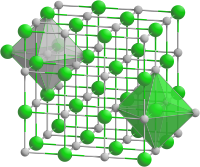


| |
| Names | |
|---|---|
| Other names
Terbium monophosphide, phosphanylidyneterbium | |
| Identifiers | |
3D model (JSmol) |
|
| EC Number |
|
PubChem CID |
|
| |
| |
| Properties | |
| PTb | |
| Molar mass | 189.899 |
| Appearance | Black crystals |
| Density | 6.82 g/cm3 |
| Structure | |
| Cubic | |
| Related compounds | |
Other anions |
Terbium nitride Terbium arsenide Terbium antimonide Terbium bismuthide |
Other cations |
Gadolinium phosphide Dysprosium phosphide |
Except where otherwise noted, data are given for materials in their standard state (at 25 °C [77 °F], 100 kPa).
| |
Terbium phosphide is an inorganic compoundofterbium and phosphorus with the chemical formula TbP.[1][2]
TbP can be obtained by the reaction of terbium and red phosphorus at 800–1000 °C:
The compound can also be obtained by the reaction of sodium phosphide and anhydrous terbium chloride at 700~800 °C.[3]
TbP undergoes a phase transition at 40 GPa from a NaCl-structure to a CsCl-structure.[4] The compound can be sintered with zinc sulfide to make a green phosphor layer.[5]
TbP forms crystals of a cubic system, space group Fm3m.[6]
The compound is a semiconductor used in high power, high frequency applications and in laser diodes and other photo diodes.[1]
|
| |
|---|---|
| Phosphides |
|
| Other compounds |
|
|
| |||||||||||||||||||||||||||||||||||||||||||||||||||||||||||||||||||||||||||||||||||||||||||||||||||||||||||||||||||||||||||||||||||||||||||||||||||||||||||||||||||||||||||||||||||||||||||||||
|---|---|---|---|---|---|---|---|---|---|---|---|---|---|---|---|---|---|---|---|---|---|---|---|---|---|---|---|---|---|---|---|---|---|---|---|---|---|---|---|---|---|---|---|---|---|---|---|---|---|---|---|---|---|---|---|---|---|---|---|---|---|---|---|---|---|---|---|---|---|---|---|---|---|---|---|---|---|---|---|---|---|---|---|---|---|---|---|---|---|---|---|---|---|---|---|---|---|---|---|---|---|---|---|---|---|---|---|---|---|---|---|---|---|---|---|---|---|---|---|---|---|---|---|---|---|---|---|---|---|---|---|---|---|---|---|---|---|---|---|---|---|---|---|---|---|---|---|---|---|---|---|---|---|---|---|---|---|---|---|---|---|---|---|---|---|---|---|---|---|---|---|---|---|---|---|---|---|---|---|---|---|---|---|---|---|---|---|---|---|---|---|
| Binary phosphides |
| ||||||||||||||||||||||||||||||||||||||||||||||||||||||||||||||||||||||||||||||||||||||||||||||||||||||||||||||||||||||||||||||||||||||||||||||||||||||||||||||||||||||||||||||||||||||||||||||
| Ternary phosphides |
| ||||||||||||||||||||||||||||||||||||||||||||||||||||||||||||||||||||||||||||||||||||||||||||||||||||||||||||||||||||||||||||||||||||||||||||||||||||||||||||||||||||||||||||||||||||||||||||||
| Quaternary phosphides |
| ||||||||||||||||||||||||||||||||||||||||||||||||||||||||||||||||||||||||||||||||||||||||||||||||||||||||||||||||||||||||||||||||||||||||||||||||||||||||||||||||||||||||||||||||||||||||||||||
| Quinary phosphides |
| ||||||||||||||||||||||||||||||||||||||||||||||||||||||||||||||||||||||||||||||||||||||||||||||||||||||||||||||||||||||||||||||||||||||||||||||||||||||||||||||||||||||||||||||||||||||||||||||
| See also |
| ||||||||||||||||||||||||||||||||||||||||||||||||||||||||||||||||||||||||||||||||||||||||||||||||||||||||||||||||||||||||||||||||||||||||||||||||||||||||||||||||||||||||||||||||||||||||||||||